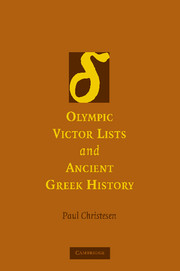Book contents
- Frontmatter
- Contents
- List of Illustrations
- List of Tables
- Preface
- A Note on Terminology, Transliterations, and Editions
- 1 An Introduction to Olympic Victor Lists
- 2 Hippias of Elis and the First Olympic Victor List
- 3 Olympionikon Anagraphai and Standard Catalogs of Olympic Victors
- 4 Olympiad Chronographies
- 5 Olympiad Chronicles
- 6 Conclusion
- Appendices
- 1.1 Scopas
- 1.2 Tiberius Claudius Polybius
- 1.3 Aristodemus of Elis
- 2 Hippias of Elis
- 3.1 Aristotle's Olympionikon Anagraphe
- 3.2 Eratosthenes' Olympionikon Anagraphe
- 3.3 The Aristotelian Pythionikai
- 3.4 POxy II 222
- 3.5 IG II2 2326
- 4.1 The Eusebian Olympic Victor List
- 4.2 Timaeus of Tauromenium
- 4.3 Dionysius of Halicarnassus
- 5.1 Philochorus
- 5.2 Ctesicles
- 5.3 Diodorus Siculus
- 5.4 Castor of Rhodes
- 5.5 Dionysius of Halicarnassus
- 5.6 Thallus
- 5.7 Phlegon
- 5.8 POxy XVII 2082
- 5.9 POxy I 12
- 5.10 Cassius Longinus
- 5.11 Dexippus
- 6 A Catalog of Olympic Victors Before Hippias?
- 7 Aristotle on the Foundation of the Olympic Truce and of the Olympic Games
- 8 Olympiads and Pankration Victors in Thucydides
- 9 More on the Accuracy of Hippias' Olympic Victor Catalog
- 10 The Olympic Victor List and the First Messenian War
- 11 Memorization and the olympic victor list
- 12 Hippias' Calculation of the Date of 776
- 13 The Spartan King Lists
- 14 Variant Olympiad Dating Systems
- 15 Menaechmus of Sicyon's Pythikos
- 16 The Sicyonian Anagraphe
- 17 Relationships between Olympionikai
- Bibliography
- General Index
- Index Locorum
17 - Relationships between Olympionikai
Published online by Cambridge University Press: 23 November 2009
- Frontmatter
- Contents
- List of Illustrations
- List of Tables
- Preface
- A Note on Terminology, Transliterations, and Editions
- 1 An Introduction to Olympic Victor Lists
- 2 Hippias of Elis and the First Olympic Victor List
- 3 Olympionikon Anagraphai and Standard Catalogs of Olympic Victors
- 4 Olympiad Chronographies
- 5 Olympiad Chronicles
- 6 Conclusion
- Appendices
- 1.1 Scopas
- 1.2 Tiberius Claudius Polybius
- 1.3 Aristodemus of Elis
- 2 Hippias of Elis
- 3.1 Aristotle's Olympionikon Anagraphe
- 3.2 Eratosthenes' Olympionikon Anagraphe
- 3.3 The Aristotelian Pythionikai
- 3.4 POxy II 222
- 3.5 IG II2 2326
- 4.1 The Eusebian Olympic Victor List
- 4.2 Timaeus of Tauromenium
- 4.3 Dionysius of Halicarnassus
- 5.1 Philochorus
- 5.2 Ctesicles
- 5.3 Diodorus Siculus
- 5.4 Castor of Rhodes
- 5.5 Dionysius of Halicarnassus
- 5.6 Thallus
- 5.7 Phlegon
- 5.8 POxy XVII 2082
- 5.9 POxy I 12
- 5.10 Cassius Longinus
- 5.11 Dexippus
- 6 A Catalog of Olympic Victors Before Hippias?
- 7 Aristotle on the Foundation of the Olympic Truce and of the Olympic Games
- 8 Olympiads and Pankration Victors in Thucydides
- 9 More on the Accuracy of Hippias' Olympic Victor Catalog
- 10 The Olympic Victor List and the First Messenian War
- 11 Memorization and the olympic victor list
- 12 Hippias' Calculation of the Date of 776
- 13 The Spartan King Lists
- 14 Variant Olympiad Dating Systems
- 15 Menaechmus of Sicyon's Pythikos
- 16 The Sicyonian Anagraphe
- 17 Relationships between Olympionikai
- Bibliography
- General Index
- Index Locorum
Summary
Tracing relationships between Olympionikai is a complex task because earlier versions influenced later ones in numerous, overlapping ways that are hard to document. Each of the three different types of Olympionikai fulfilled a relatively narrow range of functions and thus tended to contain a similar array of material arranged in similar ways. There was, in addition, an unusually high level of interconnection among Olympionikai. Later authors who compiled catalogs of Olympic victors did not feel compelled to visit Olympia and carry out their own search of the relevant records going back to the first Olympiad. They found it far more expedient to take a preexisting catalog and make the requisite additions and modifications. This is reflected in the fact that, in the places where the preserved Olympionikai overlap, they show little variation in regard to victors' names, dates, and hometowns. (The relevant information is displayed in chart form below.) The striking uniformity in the victor catalogs of Olympionikai of widely variant dates demonstrates the degree to which later authors depended upon their predecessors. Authors of Olympionikai no doubt also took from their predecessors a considerable amount of information above and beyond victors' names. Olympionikai compiled after Hippias were, therefore, to a greater or lesser degree composites of earlier, similar works. A final difficulty springs from the fact that most Olympionikai survive in fragmentary condition and many are lost entirely.
- Type
- Chapter
- Information
- Olympic Victor Lists and Ancient Greek History , pp. 519 - 532Publisher: Cambridge University PressPrint publication year: 2007



